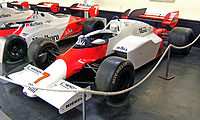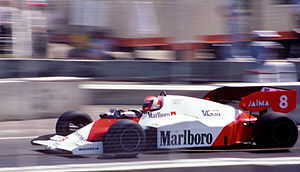- McLaren MP4/2
-
McLaren MP4/2
McLaren MP4/2B
McLaren MP4/2C
Category Formula One Constructor McLaren Designer(s) John Barnard Technical specifications[1] Chassis Carbon fibre honeycomb monocoque Engine TAG Porsche TTE PO1, 1,499 cc (91.5 cu in), V6, turbo, mid-engine, longitudinally mounted Transmission McLaren / Hewland 5-speed manual Fuel Shell Tyres 1984: Michelin
1985 / 1986: GoodyearCompetition history Notable entrants Marlboro McLaren International Notable drivers  Alain Prost
Alain Prost
 Niki Lauda
Niki Lauda
 Keke Rosberg
Keke Rosberg
 John Watson
John WatsonDebut 1984 Brazilian Grand Prix Races Wins Poles Fastest laps 48 22 7 16 Constructors' Championships 2 (1984, 1985) Drivers' Championships 3 (1984 Niki Lauda,
1985, 1986 Alain Prost)The McLaren MP4/2 was a Formula One car designed by John Barnard of McLaren for the 1984 season. An iteration of it, the MP4/2B, was used in the 1985 season, and a slightly updated version, the MP4/2C, raced in the 1986 season for McLaren. It was closely based on the MP4/1E model that was used as a test car, used in the final races of 1983.
Like the majority of its competitors, the car used an all carbon fibre chassis. The car was powered by a TAG Porsche V6 Turbo engine, which was first used in the final few races of 1983, at the insistence of Niki Lauda, who felt that the new engine required race testing before a championship challenge could be mounted. The existing chassis, the MP4/1 was modified and strengthened to take the new engine and in the final race of the 1983 season, Lauda proved the car was competitive, running at the front of the field and challenging for the lead of the race.
Lauda was joined for 1984 by Alain Prost who had narrowly lost the 1983 championship to Nelson Piquet. Prost was made the scapegoat for Renault's failure and was fired, before Ron Dennis snapped up the young Frenchman in place of John Watson. Prost and Lauda proved to be a formidable combination. Both were excellent development drivers, and both gave technical feedback on the car and the engine which pushed the car's development far further than the other teams.
 Alain Prost driving the McLaren MP4/2B at the 1985 German Grand Prix.
Alain Prost driving the McLaren MP4/2B at the 1985 German Grand Prix.
The MP4/2 was one of the few F1 cars to use carbon brakes at the time, giving it another major advantage over most of its rivals on all bar street circuits or when conditions were hot and dry; notably, the carbon brakes weren't as good as the steel brakes at tracks like the Detroit and Dallas street circuits due to the steel brakes lasting longer in the heat. That, combined to superior fuel consumption of the allowed 220 litres and the driving skill of Lauda and Prost saw the MP4/2 score 12 wins in 1984, at the time the highest number of wins in a season by a single team. Lauda beat Prost to the championship by a measly half point in the final race, even though Prost had 7 wins to Lauda's 5. Often the MP4/2's were the only cars to finish on the same lap, such was their domination. Their superiority was more obvious on high-speed circuits. McLaren comfortably won the constructors' championship from Ferrari. Although the MP4/2 was not the fastest car in qualifying (since they were the only top team not using special engines for qualifying)— often beaten by the Brabham BMW turbo — it was the most reliable and most consistent, attributes which helped it be so successful throughout its career.
For 1985, the MP4/2 was updated with cleaner aerodynamics and redesigned wings (to comply with new regulations) while TAG refined the engine. The suspension had to be redesigned after McLaren were forced to switch from Michelin to Goodyear tyres when the French company pulled out of Formula One. However, the competition had more or less caught up. Michele Alboreto (Ferrari) fought Prost for most of the season, until McLaren's greater reliability and their superiority in the high-speed circuits that followed told in both championships. Prost won his first championship with 5 wins, and McLaren claimed their second successive constructors' championship. Lauda retired from F1 at the end of the season, but not before adding a final victory to his tally in the Netherlands for the team.
The MP4/2 was almost virtually unchanged in 1986 (with the exclusion of some tweaking in aerodynamics), while Prost was joined by Finn Keke Rosberg. By this time the Williams FW11 had overtaken McLaren as the best car; notably, the MP4/2's mileage was not as good as it was in 1984 although the fuel tank size in 1984 was 220 litres where in 1986 that had dropped to 195 litres. Piquet joined Nigel Mansell at Williams and the two fought a fierce internal battle, while Prost cleverly built up his points total and snatched 4 wins from under the Williams teammates' noses. His second world championship was won more by stealth than speed as by now it was clear the TAG Porsche engine was past its best.
The MP4/2 won 22 Grands Prix (Prost, 16; Lauda, 6), took 7 pole positions (Prost, 6; Rosberg, 1), and scored 327.5 points throughout its three-year career. It contributed to 2 constructors' titles and 3 drivers' championships, and remains the most successful chassis in F1 history.
Prost's MP4/2C was driven at the 2010 Goodwood Festival of Speed by Jenson Button. [2]
Complete Formula One results
(key) (results in bold indicate pole position; results in italics indicate fastest lap)
Year Team/Chassis Engine Tyres Drivers 1 2 3 4 5 6 7 8 9 10 11 12 13 14 15 16 Points WCC 1984 McLaren
MP4/2TAG Porsche TTE PO1
V6 tcM BRA RSA BEL SMR FRA MON CAN DET DAL GBR GER AUT NED ITA EUR POR 143.5 1st Alain Prost 1 2 Ret 1 7 1 3 4 Ret Ret 1 Ret 1 Ret 1 1 Niki Lauda Ret 1 Ret Ret 1 Ret 2 Ret Ret 1 2 1 2 1 4 2 1985 McLaren
MP4/2BTAG Porsche TTE PO1
V6 tcG BRA POR SMR MON CAN DET FRA GBR GER AUT NED ITA BEL EUR RSA AUS 90 1st Niki Lauda Ret Ret 4 Ret Ret Ret Ret Ret 5 Ret 1 Ret PO Ret Ret Alain Prost 1 Ret DSQ 1 3 Ret 3 1 2 1 2 1 3 4 3 Ret John Watson 7 1986 McLaren
MP4/2CTAG Porsche TTE PO1
V6 tcG BRA ESP SMR MON BEL CAN DET FRA GBR GER HUN AUT ITA POR MEX AUS 94 2nd Alain Prost Ret 3 1 1 6 2 3 2 3 6 Ret 1 DSQ 2 2 1 Keke Rosberg Ret 4 5 2 Ret 4 Ret 4 Ret 5 Ret 9 4 Ret Ret Ret References
See also
Awards Preceded by
Brabham BT52Autosport
Racing Car Of The Year
1984Succeeded by
Williams FW10BCars that competed in the 1984 Formula One season McLaren MP4/2 • Ferrari 126C4 • Lotus 95T • Brabham BT53 • Renault RE50 • Williams FW09/FW09B • Toleman TG183B • Toleman TG184 • Alfa Romeo 184T • Arrows A6 • Arrows A7 • Ligier JS23/JS23B • Osella FA1E • Osella FA1F • Spirit 101/101B/101C • ATS D7 • RAM 01 • RAM 02 • Tyrrell 012Cars that competed in the 1985 Formula One season McLaren MP4/2B • Ferrari 156/85 • Williams FW10/FW10B • Lotus 97T • Brabham BT54 • Ligier JS25 • Renault RE60/RE60B • Arrows A8 • Tyrrell 012 • Tyrrell 014 • Minardi M185/M185B • Alfa Romeo 184T • Alfa Romeo 185T • RAM 03 • Osella FA1F • Osella FA1G • Toleman TG185 • Spirit 101D • Zakspeed 841 • Lola THL1Cars that competed in the 1986 Formula One season Williams FW11 • McLaren MP4/2C • Lotus 98T • Ferrari F1/86 • Ligier JS27 • Benetton B186 • Tyrrell 014 • Tyrrell 015 • Lola THL1 • Lola THL2 • Brabham BT54 • Brabham BT55 • Arrows A8 • Arrows A9 • Zakspeed 861 • Osella FA1F • Osella FA1G • Osella FA1H • AGS JH21C • Minardi M185B • Minardi M186 McLaren
McLarenFounder: Bruce McLaren
McLaren Group: Ron Dennis (15%) | TAG Group (15%) | Mumtalakat (30%) | Daimler AG (11%)
Current personnel: Martin Whitmarsh | Paddy Lowe | Neil Oatley
Former personnel: John Barnard | Gordon Coppuck | Pat Fry | Norbert Haug | Robin Herd | Neil Martin | Teddy Mayer | Gordon Murray | Adrian Newey | Steve Nichols | Jo Ramirez | Nicholas Tombazis
Race drivers: 3. Lewis Hamilton | 4.
Lewis Hamilton | 4.  Jenson Button
Jenson ButtonTest drivers:
 Gary Paffett |
Gary Paffett |  Pedro de la Rosa
Pedro de la Rosa
World Champions: Emerson Fittipaldi |
Emerson Fittipaldi |  Lewis Hamilton |
Lewis Hamilton |  James Hunt |
James Hunt |  Mika Häkkinen |
Mika Häkkinen |  Niki Lauda |
Niki Lauda |  Alain Prost |
Alain Prost |  Ayrton Senna
Ayrton Senna
Cars
Formula One: M2B | M4B | M5A | M7A | M7B | M7C | M7D | M9A | M14A | M14D | M19A | M19C | M23 | M26 | M28 | M29 | M29F | M30 | MP4 (MP4/1) | MP4B (MP4/1B) | MP4/1C | MP4/1E | MP4/2 | MP4/2B | MP4/2C | MP4/3 | MP4/4 | MP4/5 | MP4/5B | MP4/6 | MP4/6B | MP4/7A | MP4/8 | MP4/9 | MP4/10 | MP4/10B | MP4/10C | MP4/11 | MP4/11B | MP4/12 | MP4/13 | MP4/14 | MP4/15 | MP4-16 | MP4-17 | MP4-17D | MP4-18 | MP4-19 | MP4-19B | MP4-20 | MP4-21 | MP4-22 | MP4-23 | MP4-24 | MP4-25 | MP4-26
Formula Two: M4A | M21
Sports cars: Zerex Special | M1A | M1B | M1C | M6A | M6B | M6GT | M8A | M8B | M8C | M8D | M8E | M8F | M8FP | M12 | M20 | F1 GTR
USAC/IndyCar: M15 | M16A | M16B | M16C | M16C/D | M16E | M24
F5000/Libre: M3 | M10A | M10B | M18 | M22 | M25
Development cars: M2A
Road cars: F1 | F1 LM | SLR (for Mercedes-Benz) | MP4-12C | 799
Engines: M838TCategories:- 1984 Formula One season cars
- 1985 Formula One season cars
- 1986 Formula One season cars
- McLaren Formula One cars
Wikimedia Foundation. 2010.


